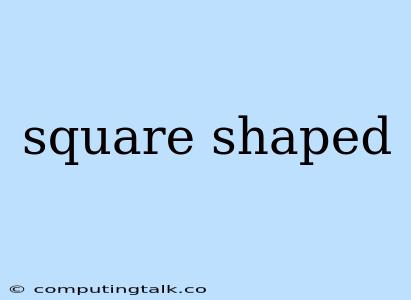The Timeless Appeal of Square Shapes
The square shape, with its four equal sides and right angles, has been a fundamental building block of design and architecture for millennia. From the ancient pyramids of Egypt to modern skyscrapers, the square shape has consistently demonstrated its versatility and enduring appeal. This article explores the reasons why the square shape continues to captivate us, examining its geometric properties, cultural significance, and applications in various fields.
Geometric Elegance and Stability
The square shape is inherently symmetrical and balanced, creating a sense of order and harmony. Its rigid structure and right angles convey stability and strength, making it an ideal choice for foundations, buildings, and other structures that require a robust foundation. This inherent stability contributes to the square shape's enduring appeal in architecture and design.
Practicality and Efficiency
Beyond its aesthetic qualities, the square shape also boasts practical benefits. Its equal sides allow for efficient use of space, making it an optimal choice for constructing rooms, furniture, and other objects. This efficiency is evident in everything from the layout of a house to the design of a computer screen.
Cultural Significance and Symbolism
The square shape has profound cultural significance across various civilizations. In ancient China, the square symbolized the earth and its stability, representing solidity and trustworthiness. In many cultures, the square shape represents a sense of order, fairness, and justice, often associated with the four cardinal directions.
Applications in Design
The square shape's versatility extends to numerous design applications. In graphic design, the square shape serves as a fundamental building block for creating logos, layouts, and other visual elements. In fashion, square shapes are commonly used for bags, scarves, and other accessories.
Modern Adaptations
While the square shape has remained a staple in design for centuries, its use has evolved with contemporary trends. Architects and designers are constantly exploring new ways to incorporate the square shape into their work, resulting in innovative and unexpected designs. The square shape can be found in everything from minimalist furniture to intricate sculptures, demonstrating its adaptability and relevance in modern aesthetics.
How Can I Incorporate Square Shapes into My Designs?
There are countless ways to incorporate square shapes into your projects. Here are a few ideas:
- Furniture: Choose furniture with square shapes, such as coffee tables, ottomans, and side tables.
- Wall Decor: Hang square-shaped artwork or mirrors on your walls.
- Accessories: Use square-shaped throw pillows, trays, or rugs to add visual interest to your space.
- Lighting: Choose lamps with square-shaped shades.
- Architecture: If you're designing a building, consider incorporating square shapes into the overall design of the structure.
Conclusion
The square shape is a powerful and timeless design element that continues to influence our built environment and inspire creativity. Its geometric elegance, practical benefits, and cultural significance contribute to its enduring appeal. Whether you're designing a logo, building a house, or simply decorating your home, the square shape offers a versatile and impactful design solution.
